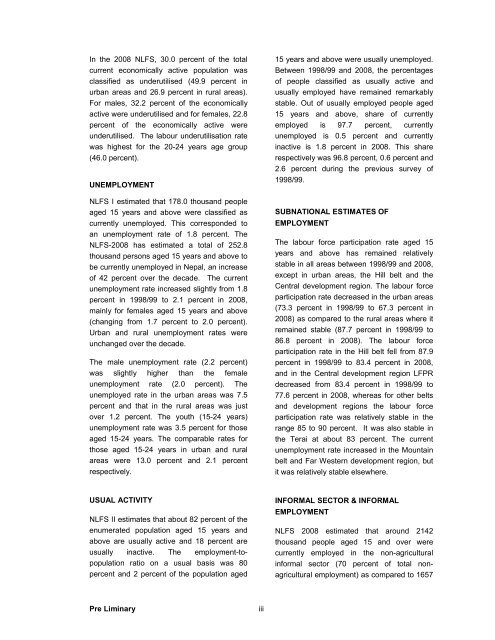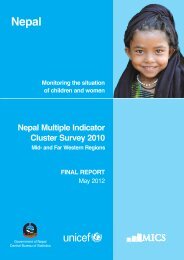Executive Summary of Nepal Labor Force Survey – 2008 (II)
Executive Summary of Nepal Labor Force Survey – 2008 (II)
Executive Summary of Nepal Labor Force Survey – 2008 (II)
You also want an ePaper? Increase the reach of your titles
YUMPU automatically turns print PDFs into web optimized ePapers that Google loves.
In the <strong>2008</strong> NLFS, 30.0 percent <strong>of</strong> the total<br />
current economically active population was<br />
classified as underutilised (49.9 percent in<br />
urban areas and 26.9 percent in rural areas).<br />
For males, 32.2 percent <strong>of</strong> the economically<br />
active were underutilised and for females, 22.8<br />
percent <strong>of</strong> the economically active were<br />
underutilised. The labour underutilisation rate<br />
was highest for the 20-24 years age group<br />
(46.0 percent).<br />
UNEMPLOYMENT<br />
NLFS I estimated that 178.0 thousand people<br />
aged 15 years and above were classified as<br />
currently unemployed. This corresponded to<br />
an unemployment rate <strong>of</strong> 1.8 percent. The<br />
NLFS-<strong>2008</strong> has estimated a total <strong>of</strong> 252.8<br />
thousand persons aged 15 years and above to<br />
be currently unemployed in <strong>Nepal</strong>, an increase<br />
<strong>of</strong> 42 percent over the decade. The current<br />
unemployment rate increased slightly from 1.8<br />
percent in 1998/99 to 2.1 percent in <strong>2008</strong>,<br />
mainly for females aged 15 years and above<br />
(changing from 1.7 percent to 2.0 percent).<br />
Urban and rural unemployment rates were<br />
unchanged over the decade.<br />
The male unemployment rate (2.2 percent)<br />
was slightly higher than the female<br />
unemployment rate (2.0 percent). The<br />
unemployed rate in the urban areas was 7.5<br />
percent and that in the rural areas was just<br />
over 1.2 percent. The youth (15-24 years)<br />
unemployment rate was 3.5 percent for those<br />
aged 15-24 years. The comparable rates for<br />
those aged 15-24 years in urban and rural<br />
areas were 13.0 percent and 2.1 percent<br />
respectively.<br />
15 years and above were usually unemployed.<br />
Between 1998/99 and <strong>2008</strong>, the percentages<br />
<strong>of</strong> people classified as usually active and<br />
usually employed have remained remarkably<br />
stable. Out <strong>of</strong> usually employed people aged<br />
15 years and above, share <strong>of</strong> currently<br />
employed is 97.7 percent, currently<br />
unemployed is 0.5 percent and currently<br />
inactive is 1.8 percent in <strong>2008</strong>. This share<br />
respectively was 96.8 percent, 0.6 percent and<br />
2.6 percent during the previous survey <strong>of</strong><br />
1998/99.<br />
SUBNATIONAL ESTIMATES OF<br />
EMPLOYMENT<br />
The labour force participation rate aged 15<br />
years and above has remained relatively<br />
stable in all areas between 1998/99 and <strong>2008</strong>,<br />
except in urban areas, the Hill belt and the<br />
Central development region. The labour force<br />
participation rate decreased in the urban areas<br />
(73.3 percent in 1998/99 to 67.3 percent in<br />
<strong>2008</strong>) as compared to the rural areas where it<br />
remained stable (87.7 percent in 1998/99 to<br />
86.8 percent in <strong>2008</strong>). The labour force<br />
participation rate in the Hill belt fell from 87.9<br />
percent in 1998/99 to 83.4 percent in <strong>2008</strong>,<br />
and in the Central development region LFPR<br />
decreased from 83.4 percent in 1998/99 to<br />
77.6 percent in <strong>2008</strong>, whereas for other belts<br />
and development regions the labour force<br />
participation rate was relatively stable in the<br />
range 85 to 90 percent. It was also stable in<br />
the Terai at about 83 percent. The current<br />
unemployment rate increased in the Mountain<br />
belt and Far Western development region, but<br />
it was relatively stable elsewhere.<br />
USUAL ACTIVITY<br />
NLFS <strong>II</strong> estimates that about 82 percent <strong>of</strong> the<br />
enumerated population aged 15 years and<br />
above are usually active and 18 percent are<br />
usually inactive. The employment-topopulation<br />
ratio on a usual basis was 80<br />
percent and 2 percent <strong>of</strong> the population aged<br />
INFORMAL SECTOR & INFORMAL<br />
EMPLOYMENT<br />
NLFS <strong>2008</strong> estimated that around 2142<br />
thousand people aged 15 and over were<br />
currently employed in the non-agricultural<br />
informal sector (70 percent <strong>of</strong> total nonagricultural<br />
employment) as compared to 1657<br />
Pre Liminary<br />
iii
















